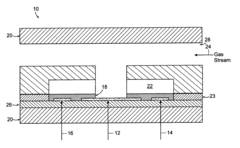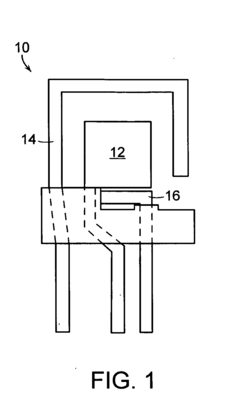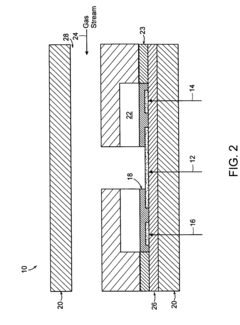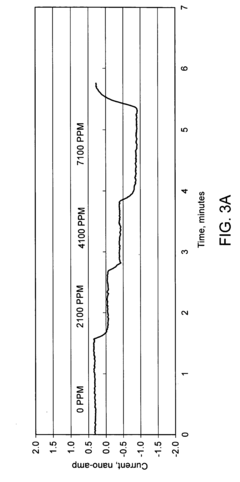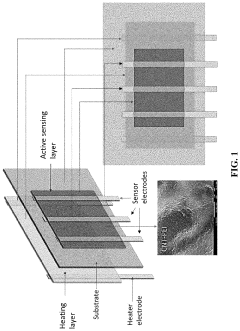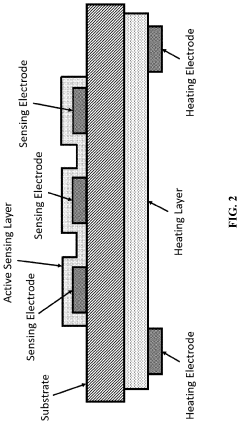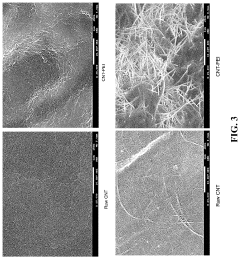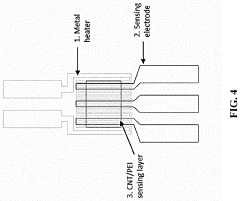Innovations in Carbon Tetrachloride Sensing Technologies
JUL 3, 20259 MIN READ
Generate Your Research Report Instantly with AI Agent
Patsnap Eureka helps you evaluate technical feasibility & market potential.
CCl4 Sensing Background
Carbon tetrachloride (CCl4) sensing has become increasingly important in environmental monitoring, industrial safety, and public health protection. The background of CCl4 sensing technologies spans several decades, with significant advancements in recent years driven by growing environmental concerns and stricter regulations.
CCl4, a colorless and volatile organic compound, was once widely used in various applications, including as a cleaning agent, refrigerant, and pesticide. However, its harmful effects on human health and the environment, particularly its role in ozone depletion, led to its phase-out under the Montreal Protocol in 1987. Despite this, CCl4 remains a persistent environmental pollutant due to its long atmospheric lifetime and continued emissions from legacy sources.
The need for accurate and reliable CCl4 detection has spurred the development of various sensing technologies. Early detection methods relied primarily on laboratory-based techniques such as gas chromatography and mass spectrometry. While highly accurate, these methods were time-consuming, expensive, and not suitable for real-time, on-site monitoring.
As environmental regulations tightened and awareness of CCl4's health risks grew, there was a push towards developing more portable, rapid, and cost-effective sensing solutions. This led to the exploration of new sensing principles and materials, including electrochemical sensors, optical sensors, and nanomaterial-based detectors.
The advent of nanotechnology has been particularly influential in advancing CCl4 sensing capabilities. Nanomaterials such as carbon nanotubes, graphene, and metal oxide nanoparticles have shown promising results in enhancing sensor sensitivity and selectivity. These materials offer high surface-to-volume ratios and unique electronic properties that can be exploited for improved CCl4 detection.
In recent years, the integration of smart technologies and Internet of Things (IoT) concepts has further transformed CCl4 sensing. Wireless sensor networks and cloud-based data analytics have enabled real-time monitoring and data collection across large areas, enhancing our ability to track CCl4 levels and identify potential sources of emissions.
The evolution of CCl4 sensing technologies reflects broader trends in environmental monitoring and analytical chemistry. It demonstrates the ongoing challenge of balancing sensitivity, selectivity, cost-effectiveness, and practicality in sensor design. As global efforts to mitigate environmental pollution continue, innovations in CCl4 sensing are likely to play a crucial role in ensuring compliance with regulations and protecting both human health and the environment.
CCl4, a colorless and volatile organic compound, was once widely used in various applications, including as a cleaning agent, refrigerant, and pesticide. However, its harmful effects on human health and the environment, particularly its role in ozone depletion, led to its phase-out under the Montreal Protocol in 1987. Despite this, CCl4 remains a persistent environmental pollutant due to its long atmospheric lifetime and continued emissions from legacy sources.
The need for accurate and reliable CCl4 detection has spurred the development of various sensing technologies. Early detection methods relied primarily on laboratory-based techniques such as gas chromatography and mass spectrometry. While highly accurate, these methods were time-consuming, expensive, and not suitable for real-time, on-site monitoring.
As environmental regulations tightened and awareness of CCl4's health risks grew, there was a push towards developing more portable, rapid, and cost-effective sensing solutions. This led to the exploration of new sensing principles and materials, including electrochemical sensors, optical sensors, and nanomaterial-based detectors.
The advent of nanotechnology has been particularly influential in advancing CCl4 sensing capabilities. Nanomaterials such as carbon nanotubes, graphene, and metal oxide nanoparticles have shown promising results in enhancing sensor sensitivity and selectivity. These materials offer high surface-to-volume ratios and unique electronic properties that can be exploited for improved CCl4 detection.
In recent years, the integration of smart technologies and Internet of Things (IoT) concepts has further transformed CCl4 sensing. Wireless sensor networks and cloud-based data analytics have enabled real-time monitoring and data collection across large areas, enhancing our ability to track CCl4 levels and identify potential sources of emissions.
The evolution of CCl4 sensing technologies reflects broader trends in environmental monitoring and analytical chemistry. It demonstrates the ongoing challenge of balancing sensitivity, selectivity, cost-effectiveness, and practicality in sensor design. As global efforts to mitigate environmental pollution continue, innovations in CCl4 sensing are likely to play a crucial role in ensuring compliance with regulations and protecting both human health and the environment.
Market Demand Analysis
The market demand for carbon tetrachloride sensing technologies has been steadily growing due to increasing environmental concerns and stringent regulations on hazardous substances. Carbon tetrachloride, a potent ozone-depleting substance and potential carcinogen, has been phased out in many applications. However, its persistence in the environment and potential for illegal use necessitate robust sensing technologies for detection and monitoring.
The primary drivers of market demand include environmental monitoring agencies, industrial safety sectors, and research institutions. Environmental agencies require advanced sensing technologies to detect trace amounts of carbon tetrachloride in air, water, and soil samples. This demand is particularly high in regions with a history of industrial contamination or where the substance may still be in limited use.
In the industrial safety sector, there is a growing need for real-time, on-site detection systems. Industries such as chemical manufacturing, waste management, and remediation services require reliable sensing technologies to ensure worker safety and compliance with environmental regulations. The ability to quickly detect and quantify carbon tetrachloride levels is crucial for preventing exposure and managing potential leaks or spills.
Research institutions and laboratories also contribute significantly to the market demand. As studies on the long-term environmental impacts of carbon tetrachloride continue, there is an ongoing need for highly sensitive and accurate detection methods. This demand extends to forensic applications, where trace analysis of carbon tetrachloride can provide valuable information in environmental crime investigations.
The global market for carbon tetrachloride sensing technologies is expected to expand as developing countries strengthen their environmental protection policies. Emerging economies, particularly in Asia and South America, are implementing stricter regulations on hazardous substances, driving the adoption of advanced sensing technologies.
Technological advancements are also shaping market demand. There is a growing preference for portable, user-friendly devices that can provide rapid, on-site analysis. This trend is pushing manufacturers to develop miniaturized sensors with improved sensitivity and selectivity. Additionally, the integration of IoT and cloud-based data management systems is becoming increasingly important, allowing for real-time monitoring and data analysis across multiple locations.
The market is also seeing a shift towards multi-functional sensing platforms that can detect a range of chlorinated compounds, including carbon tetrachloride. This versatility is particularly attractive to end-users looking to optimize their investment in sensing technologies.
As awareness of the health and environmental risks associated with carbon tetrachloride continues to grow, the demand for innovative sensing technologies is expected to increase. This presents significant opportunities for technology developers and manufacturers to address the evolving needs of various sectors, from environmental protection to industrial safety and scientific research.
The primary drivers of market demand include environmental monitoring agencies, industrial safety sectors, and research institutions. Environmental agencies require advanced sensing technologies to detect trace amounts of carbon tetrachloride in air, water, and soil samples. This demand is particularly high in regions with a history of industrial contamination or where the substance may still be in limited use.
In the industrial safety sector, there is a growing need for real-time, on-site detection systems. Industries such as chemical manufacturing, waste management, and remediation services require reliable sensing technologies to ensure worker safety and compliance with environmental regulations. The ability to quickly detect and quantify carbon tetrachloride levels is crucial for preventing exposure and managing potential leaks or spills.
Research institutions and laboratories also contribute significantly to the market demand. As studies on the long-term environmental impacts of carbon tetrachloride continue, there is an ongoing need for highly sensitive and accurate detection methods. This demand extends to forensic applications, where trace analysis of carbon tetrachloride can provide valuable information in environmental crime investigations.
The global market for carbon tetrachloride sensing technologies is expected to expand as developing countries strengthen their environmental protection policies. Emerging economies, particularly in Asia and South America, are implementing stricter regulations on hazardous substances, driving the adoption of advanced sensing technologies.
Technological advancements are also shaping market demand. There is a growing preference for portable, user-friendly devices that can provide rapid, on-site analysis. This trend is pushing manufacturers to develop miniaturized sensors with improved sensitivity and selectivity. Additionally, the integration of IoT and cloud-based data management systems is becoming increasingly important, allowing for real-time monitoring and data analysis across multiple locations.
The market is also seeing a shift towards multi-functional sensing platforms that can detect a range of chlorinated compounds, including carbon tetrachloride. This versatility is particularly attractive to end-users looking to optimize their investment in sensing technologies.
As awareness of the health and environmental risks associated with carbon tetrachloride continues to grow, the demand for innovative sensing technologies is expected to increase. This presents significant opportunities for technology developers and manufacturers to address the evolving needs of various sectors, from environmental protection to industrial safety and scientific research.
Technical Challenges
Carbon tetrachloride sensing technologies face several significant technical challenges that hinder their widespread adoption and effectiveness. One of the primary obstacles is the development of highly sensitive and selective sensors capable of detecting low concentrations of carbon tetrachloride in complex environmental matrices. Current sensing methods often struggle to differentiate between carbon tetrachloride and other similar halogenated compounds, leading to potential false positives or inaccurate measurements.
Another major challenge lies in the stability and longevity of sensing materials. Many existing sensors suffer from degradation or poisoning when exposed to carbon tetrachloride or other environmental contaminants over extended periods. This limitation necessitates frequent calibration or replacement, increasing operational costs and reducing the reliability of long-term monitoring systems.
The miniaturization of sensing devices presents an additional hurdle. While there is a growing demand for portable and field-deployable carbon tetrachloride sensors, reducing the size of the sensing apparatus without compromising performance remains a significant engineering challenge. Balancing sensitivity, selectivity, and portability requires innovative approaches in materials science and device design.
Real-time monitoring capabilities are also a critical area for improvement. Many current sensing technologies rely on laboratory analysis or have significant response times, limiting their usefulness in scenarios where rapid detection is crucial, such as industrial leak detection or emergency response situations.
Environmental factors pose another set of challenges for carbon tetrachloride sensing technologies. Temperature fluctuations, humidity, and the presence of interfering gases can all affect sensor performance. Developing robust sensors that maintain accuracy across a wide range of environmental conditions is essential for reliable field applications.
Power consumption is a concern, particularly for remote or continuous monitoring applications. Energy-efficient sensing technologies that can operate for extended periods on limited power sources are in high demand but remain technically challenging to achieve without sacrificing performance.
Lastly, the integration of carbon tetrachloride sensors with data analytics and IoT platforms presents both opportunities and challenges. While such integration could greatly enhance monitoring capabilities and data interpretation, it requires addressing issues related to data security, wireless communication in harsh environments, and the development of sophisticated algorithms for real-time data analysis and decision-making.
Addressing these technical challenges will be crucial for advancing carbon tetrachloride sensing technologies and expanding their applications in environmental monitoring, industrial safety, and public health protection.
Another major challenge lies in the stability and longevity of sensing materials. Many existing sensors suffer from degradation or poisoning when exposed to carbon tetrachloride or other environmental contaminants over extended periods. This limitation necessitates frequent calibration or replacement, increasing operational costs and reducing the reliability of long-term monitoring systems.
The miniaturization of sensing devices presents an additional hurdle. While there is a growing demand for portable and field-deployable carbon tetrachloride sensors, reducing the size of the sensing apparatus without compromising performance remains a significant engineering challenge. Balancing sensitivity, selectivity, and portability requires innovative approaches in materials science and device design.
Real-time monitoring capabilities are also a critical area for improvement. Many current sensing technologies rely on laboratory analysis or have significant response times, limiting their usefulness in scenarios where rapid detection is crucial, such as industrial leak detection or emergency response situations.
Environmental factors pose another set of challenges for carbon tetrachloride sensing technologies. Temperature fluctuations, humidity, and the presence of interfering gases can all affect sensor performance. Developing robust sensors that maintain accuracy across a wide range of environmental conditions is essential for reliable field applications.
Power consumption is a concern, particularly for remote or continuous monitoring applications. Energy-efficient sensing technologies that can operate for extended periods on limited power sources are in high demand but remain technically challenging to achieve without sacrificing performance.
Lastly, the integration of carbon tetrachloride sensors with data analytics and IoT platforms presents both opportunities and challenges. While such integration could greatly enhance monitoring capabilities and data interpretation, it requires addressing issues related to data security, wireless communication in harsh environments, and the development of sophisticated algorithms for real-time data analysis and decision-making.
Addressing these technical challenges will be crucial for advancing carbon tetrachloride sensing technologies and expanding their applications in environmental monitoring, industrial safety, and public health protection.
Current Sensing Methods
01 Optical sensing methods for carbon tetrachloride
Optical sensing techniques are employed to detect carbon tetrachloride. These methods may involve spectroscopic analysis, such as infrared or ultraviolet spectroscopy, to identify the unique spectral signatures of carbon tetrachloride. Optical sensors can provide rapid and non-invasive detection of the compound in various environments.- Optical sensing methods for carbon tetrachloride: Optical sensing techniques are employed to detect carbon tetrachloride. These methods may involve spectroscopic analysis, such as infrared or ultraviolet spectroscopy, to identify the unique spectral signatures of carbon tetrachloride. Optical sensors can provide rapid and non-invasive detection of the compound in various environments.
- Electrochemical detection of carbon tetrachloride: Electrochemical sensors are developed for the detection of carbon tetrachloride. These sensors may utilize electrode materials that react specifically with carbon tetrachloride, producing measurable electrical signals. Electrochemical methods can offer high sensitivity and selectivity in detecting carbon tetrachloride in liquid or gaseous samples.
- Gas chromatography for carbon tetrachloride analysis: Gas chromatography techniques are employed to separate and detect carbon tetrachloride from complex mixtures. This method allows for precise quantification of carbon tetrachloride in various samples, including air and water. Advanced detectors coupled with gas chromatographs can provide highly sensitive and specific analysis of carbon tetrachloride.
- Colorimetric sensing of carbon tetrachloride: Colorimetric sensors are developed for visual detection of carbon tetrachloride. These sensors typically involve chemical reactions that produce a color change in the presence of carbon tetrachloride. Such methods can provide rapid, on-site detection without the need for complex instrumentation, making them suitable for field applications.
- Nanomaterial-based sensors for carbon tetrachloride: Advanced nanomaterials are utilized to create highly sensitive sensors for carbon tetrachloride detection. These may include carbon nanotubes, graphene, or metal nanoparticles that exhibit unique properties when exposed to carbon tetrachloride. Nanomaterial-based sensors can offer enhanced sensitivity, faster response times, and improved selectivity in detecting carbon tetrachloride.
02 Electrochemical detection of carbon tetrachloride
Electrochemical sensors are developed for the detection of carbon tetrachloride. These sensors may utilize electrodes modified with specific materials or coatings that react with or adsorb carbon tetrachloride, resulting in measurable electrical changes. This approach offers high sensitivity and selectivity for carbon tetrachloride detection in liquid or gaseous samples.Expand Specific Solutions03 Gas chromatography for carbon tetrachloride analysis
Gas chromatography techniques are employed for the separation and detection of carbon tetrachloride. This method allows for precise quantification of carbon tetrachloride in complex mixtures. Various detectors, such as mass spectrometers or electron capture detectors, may be coupled with gas chromatography for enhanced sensitivity and specificity.Expand Specific Solutions04 Colorimetric sensing of carbon tetrachloride
Colorimetric sensors are developed for the visual detection of carbon tetrachloride. These sensors typically involve materials that change color upon exposure to carbon tetrachloride, allowing for easy and rapid identification. Such sensors may be incorporated into test strips or other portable devices for field use.Expand Specific Solutions05 Nanomaterial-based sensors for carbon tetrachloride
Advanced nanomaterials are utilized in the development of highly sensitive carbon tetrachloride sensors. These may include carbon nanotubes, graphene, or metal nanoparticles that exhibit unique electrical or optical properties when exposed to carbon tetrachloride. Nanomaterial-based sensors offer the potential for miniaturization and enhanced detection limits.Expand Specific Solutions
Key Industry Players
The carbon tetrachloride sensing technology market is in a growth phase, driven by increasing environmental regulations and industrial safety concerns. The market size is expanding, with projections indicating significant growth in the coming years. Technologically, the field is advancing rapidly, with various players contributing to innovations. Companies like Giner, Inc. and i-SENS, Inc. are developing electrochemical sensor technologies, while research institutions such as Fraunhofer-Gesellschaft and Colorado State University are exploring novel sensing methods. The involvement of major corporations like Apple, Inc. and Robert Bosch GmbH suggests a growing interest in integrating these sensors into consumer and industrial products, indicating a maturing market with diverse applications across multiple sectors.
Fraunhofer-Gesellschaft eV
Technical Solution: Fraunhofer-Gesellschaft has developed innovative carbon tetrachloride sensing technologies using advanced spectroscopic methods. Their approach utilizes mid-infrared quantum cascade lasers (QCLs) for highly sensitive and selective detection of carbon tetrachloride in air and water samples. The system employs a multi-pass gas cell to enhance sensitivity, achieving detection limits in the parts-per-billion (ppb) range[1]. Additionally, they have integrated machine learning algorithms to improve signal processing and reduce false positives, enhancing the overall reliability of the sensing platform[2]. The technology also incorporates real-time monitoring capabilities, allowing for continuous environmental surveillance in industrial settings[3].
Strengths: High sensitivity and selectivity, real-time monitoring capabilities, and integration of AI for improved accuracy. Weaknesses: Potentially high cost due to advanced components, and may require specialized maintenance.
The Quantum Group, Inc.
Technical Solution: The Quantum Group has pioneered a novel approach to carbon tetrachloride sensing using quantum dot-based fluorescence quenching. Their technology employs specially engineered quantum dots that exhibit strong fluorescence, which is selectively quenched in the presence of carbon tetrachloride molecules. This method allows for rapid, highly sensitive detection with minimal sample preparation[4]. The company has also developed a portable, handheld device incorporating this technology, enabling on-site measurements in various environmental and industrial settings. The sensor system includes a microfluidic chip for sample handling and a miniaturized spectrometer for fluorescence detection, all controlled by a user-friendly smartphone app[5].
Strengths: Highly portable, rapid detection, and user-friendly interface. Weaknesses: May be affected by other fluorescence-quenching compounds, potentially leading to false positives in complex matrices.
Core Sensing Innovations
Electrochemical carbon dioxide sensor
PatentActiveUS20060096871A1
Innovation
- A solid electrochemical carbon dioxide sensor utilizing a non-conductive substrate with metal oxide sensing electrodes, a reference electrode, and a counter electrode in contact with a solid polymer electrolyte anion-exchange membrane, which employs reversible electrochemical reactions to detect CO2, allowing for quantitative measurement and operation over a wide humidity and temperature range.
Printable carbon nanotube-based carbon dioxide sensor
PatentPendingUS20230065235A1
Innovation
- A carbon dioxide sensor using a printable paste of PEI-functionalized carbon nanomaterials with branched polyethyleneimine polymers, which forms an active sensing layer that absorbs and desorbs CO2 reversibly, allowing for stable conductivity changes at room temperature, and incorporates a heating layer for temperature control and analyte removal.
Environmental Regulations
Environmental regulations play a crucial role in shaping the development and implementation of carbon tetrachloride sensing technologies. These regulations are designed to protect human health and the environment from the harmful effects of this toxic substance. The United States Environmental Protection Agency (EPA) has established strict guidelines for the use, handling, and disposal of carbon tetrachloride under the Clean Air Act and the Toxic Substances Control Act.
The EPA has set a maximum contaminant level (MCL) for carbon tetrachloride in drinking water at 0.005 mg/L or 5 parts per billion (ppb). This stringent limit necessitates highly sensitive and accurate sensing technologies to ensure compliance. Additionally, the Occupational Safety and Health Administration (OSHA) has established permissible exposure limits (PELs) for carbon tetrachloride in the workplace, further driving the need for advanced sensing capabilities.
Internationally, the Montreal Protocol on Substances that Deplete the Ozone Layer has phased out the production and consumption of carbon tetrachloride, except for essential uses. This global agreement has significantly reduced the release of carbon tetrachloride into the atmosphere but has also increased the importance of monitoring residual levels and potential illegal use.
The European Union's REACH (Registration, Evaluation, Authorization, and Restriction of Chemicals) regulation has classified carbon tetrachloride as a substance of very high concern (SVHC). This classification imposes strict requirements on manufacturers, importers, and downstream users to manage risks associated with its use and to seek authorization for specific applications.
These regulatory frameworks have driven innovation in carbon tetrachloride sensing technologies, pushing for the development of more sensitive, accurate, and reliable detection methods. Researchers and manufacturers are focusing on creating sensors that can detect carbon tetrachloride at increasingly lower concentrations, with improved selectivity to distinguish it from other similar compounds.
The regulatory landscape also emphasizes the need for real-time monitoring systems, particularly in industrial settings where carbon tetrachloride may still be used in controlled processes. This has led to the development of portable and continuous monitoring devices that can provide immediate alerts when concentration levels exceed regulatory thresholds.
Furthermore, environmental regulations have spurred interest in remote sensing technologies for carbon tetrachloride detection. Satellite-based and ground-based remote sensing systems are being explored to monitor large areas for potential emissions, supporting global efforts to enforce international agreements and identify unauthorized sources.
As regulations continue to evolve, sensing technologies must adapt to meet new standards and requirements. This dynamic relationship between environmental policy and technological innovation ensures ongoing advancements in the field of carbon tetrachloride detection and monitoring.
The EPA has set a maximum contaminant level (MCL) for carbon tetrachloride in drinking water at 0.005 mg/L or 5 parts per billion (ppb). This stringent limit necessitates highly sensitive and accurate sensing technologies to ensure compliance. Additionally, the Occupational Safety and Health Administration (OSHA) has established permissible exposure limits (PELs) for carbon tetrachloride in the workplace, further driving the need for advanced sensing capabilities.
Internationally, the Montreal Protocol on Substances that Deplete the Ozone Layer has phased out the production and consumption of carbon tetrachloride, except for essential uses. This global agreement has significantly reduced the release of carbon tetrachloride into the atmosphere but has also increased the importance of monitoring residual levels and potential illegal use.
The European Union's REACH (Registration, Evaluation, Authorization, and Restriction of Chemicals) regulation has classified carbon tetrachloride as a substance of very high concern (SVHC). This classification imposes strict requirements on manufacturers, importers, and downstream users to manage risks associated with its use and to seek authorization for specific applications.
These regulatory frameworks have driven innovation in carbon tetrachloride sensing technologies, pushing for the development of more sensitive, accurate, and reliable detection methods. Researchers and manufacturers are focusing on creating sensors that can detect carbon tetrachloride at increasingly lower concentrations, with improved selectivity to distinguish it from other similar compounds.
The regulatory landscape also emphasizes the need for real-time monitoring systems, particularly in industrial settings where carbon tetrachloride may still be used in controlled processes. This has led to the development of portable and continuous monitoring devices that can provide immediate alerts when concentration levels exceed regulatory thresholds.
Furthermore, environmental regulations have spurred interest in remote sensing technologies for carbon tetrachloride detection. Satellite-based and ground-based remote sensing systems are being explored to monitor large areas for potential emissions, supporting global efforts to enforce international agreements and identify unauthorized sources.
As regulations continue to evolve, sensing technologies must adapt to meet new standards and requirements. This dynamic relationship between environmental policy and technological innovation ensures ongoing advancements in the field of carbon tetrachloride detection and monitoring.
Health and Safety Impact
Carbon tetrachloride (CCl4) is a highly toxic compound that poses significant health and safety risks. The development of innovative sensing technologies for CCl4 detection has far-reaching implications for occupational safety, environmental protection, and public health. These advancements play a crucial role in mitigating the potential hazards associated with CCl4 exposure.
Improved CCl4 sensing technologies contribute to enhanced workplace safety in industries where this chemical is used or produced. Early detection of CCl4 leaks or spills allows for prompt intervention, reducing the risk of acute and chronic health effects among workers. This is particularly important in sectors such as dry cleaning, refrigeration, and chemical manufacturing, where CCl4 exposure has historically been a concern.
Environmental monitoring benefits greatly from innovations in CCl4 sensing. These technologies enable more effective detection of CCl4 in air, water, and soil, facilitating better environmental management and remediation efforts. This is crucial given CCl4's persistence in the environment and its potential to contaminate groundwater sources.
Public health protection is another significant impact of advanced CCl4 sensing technologies. By improving the ability to detect CCl4 in residential and commercial settings, these innovations help prevent accidental exposures and protect vulnerable populations. This is especially relevant in areas with legacy contamination or in proximity to industrial sites.
The health effects of CCl4 exposure, including liver and kidney damage, central nervous system depression, and potential carcinogenicity, underscore the importance of accurate and sensitive detection methods. Innovations in sensing technologies contribute to more precise exposure assessments, enabling better risk management and health monitoring strategies.
Regulatory compliance and enforcement are also enhanced by improved CCl4 sensing capabilities. These technologies support more effective implementation of environmental and occupational health regulations, ensuring that exposure limits are not exceeded and that remediation efforts are properly targeted.
Furthermore, advancements in CCl4 sensing technologies have broader implications for chemical safety. The principles and methods developed for CCl4 detection often have applications for sensing other hazardous substances, contributing to overall improvements in chemical safety practices across various industries.
In conclusion, innovations in carbon tetrachloride sensing technologies have a profound impact on health and safety across multiple domains. By enabling earlier detection, more accurate monitoring, and better risk management, these advancements play a vital role in protecting workers, communities, and the environment from the hazards associated with CCl4 exposure.
Improved CCl4 sensing technologies contribute to enhanced workplace safety in industries where this chemical is used or produced. Early detection of CCl4 leaks or spills allows for prompt intervention, reducing the risk of acute and chronic health effects among workers. This is particularly important in sectors such as dry cleaning, refrigeration, and chemical manufacturing, where CCl4 exposure has historically been a concern.
Environmental monitoring benefits greatly from innovations in CCl4 sensing. These technologies enable more effective detection of CCl4 in air, water, and soil, facilitating better environmental management and remediation efforts. This is crucial given CCl4's persistence in the environment and its potential to contaminate groundwater sources.
Public health protection is another significant impact of advanced CCl4 sensing technologies. By improving the ability to detect CCl4 in residential and commercial settings, these innovations help prevent accidental exposures and protect vulnerable populations. This is especially relevant in areas with legacy contamination or in proximity to industrial sites.
The health effects of CCl4 exposure, including liver and kidney damage, central nervous system depression, and potential carcinogenicity, underscore the importance of accurate and sensitive detection methods. Innovations in sensing technologies contribute to more precise exposure assessments, enabling better risk management and health monitoring strategies.
Regulatory compliance and enforcement are also enhanced by improved CCl4 sensing capabilities. These technologies support more effective implementation of environmental and occupational health regulations, ensuring that exposure limits are not exceeded and that remediation efforts are properly targeted.
Furthermore, advancements in CCl4 sensing technologies have broader implications for chemical safety. The principles and methods developed for CCl4 detection often have applications for sensing other hazardous substances, contributing to overall improvements in chemical safety practices across various industries.
In conclusion, innovations in carbon tetrachloride sensing technologies have a profound impact on health and safety across multiple domains. By enabling earlier detection, more accurate monitoring, and better risk management, these advancements play a vital role in protecting workers, communities, and the environment from the hazards associated with CCl4 exposure.
Unlock deeper insights with Patsnap Eureka Quick Research — get a full tech report to explore trends and direct your research. Try now!
Generate Your Research Report Instantly with AI Agent
Supercharge your innovation with Patsnap Eureka AI Agent Platform!
